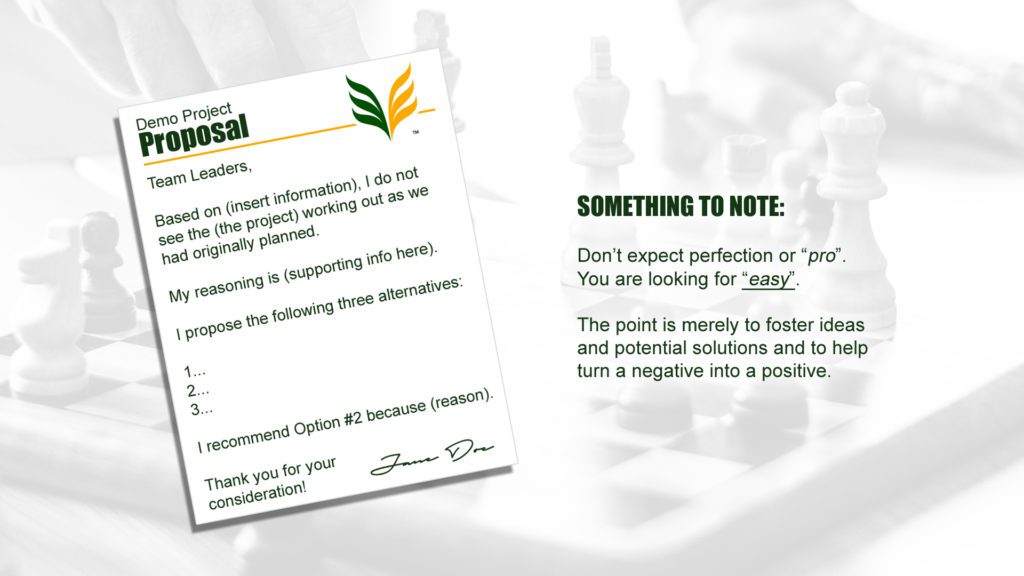The GrassFire Proposal Model
The GrassFire Proposal Model (GF Proposal Model) is a suggestion that I provide to my students regarding organizational communication, problem identification and evaluation, and resolution exploration.
Follow your organization’s formatting expectations and norms regarding layout.
Step 1: Provide your proposal to leadership in a typed format. This is to ensure professionalism, legibility, and conciseness. Additionally, ensure that you have made a copy for yourself and that the file is saved in a secure location.
Step 2: The presentation should open with a clear and concise description of the issue to be considered. This should not be overly wordy or long. Ensure that this part lays out the issue in a matter-of-fact way and attempts to remove emotional bias from the proposal.
Step 3: Next, you will want to provide a detailed explanation of why it is an issue and/or what will likely occur as a result of this issue.
Step 4: Provide at least three viable and detailed solutions for the issue being presented. Having three options provides for better decision-making and demonstrates that you are not providing knee-jerk reactions.
Step 5: Provide a recommendation for one of the solutions listed. This allows you to demonstrate deep thought and decision-making capabilities.
Step 6: Provide an explanation of exactly why you have chosen the selected solution. This merely supports the previous steps and provides rationale and context for leadership to consider.
This model is a great supplement for use with the Three Part Communication Model and Validation Exchange Theory.
Use of this work is permitted with proper citation.
- In-Text: (Robertson, 2018)
- Bibliography: Robertson, D. (2018). GF Proposal Model. [online] DMR Publications. Available at: https://www.dmrpublications.com/2018/09/the-grassfire-proposal-model/ [Accessed Date].
- Link To: https://www.dmrpublications.com/2018/09/the-grassfire-proposal-model/

A More Advanced Approach
This template follows the previous one but provides a little more structure and a few options to consider.
Title: Proposal for [Insert Service or Product]
Introduction:
Briefly introduce your organization and the services or products you offer
Provide an overview of the issue you will be addressing in the proposal
Issue:
Clearly state the issue that needs to be addressed, including any relevant background information
Provide statistics or other data to support the need for a solution
Why it’s an issue:
Explain the impact of the issue on the client’s organization and why it needs to be addressed
Highlight any potential risks or negative consequences if the issue is not addressed
Solution #1:
Clearly describe the first solution being proposed, including any relevant details and benefits
Provide an estimate of the cost and timeline for implementation
Solution #2:
Clearly describe the second solution being proposed, including any relevant details and benefits
Provide an estimate of the cost and timeline for implementation
Solution #3:
Clearly describe the third solution being proposed, including any relevant details and benefits
Provide an estimate of the cost and timeline for implementation
Professional Recommendation & Solution Choice:
Provide a brief summary of the solutions proposed and recommend the solution that you believe is the best fit for the client’s needs
Reason for the Selection of the Chosen Solution:
Provide a detailed explanation of why the chosen solution is the best fit for the client’s needs, including how it addresses the issue and how it aligns with the client’s goals and objectives
Optionals (Addressed Below):
If necessary, include some of the optional pieces addressed below.
Conclusion:
- Summarize the proposal, including the issue, solutions proposed, professional recommendation, and reason for the selection of the chosen solution
- Include a call to action, such as requesting a meeting to discuss the proposal further or requesting a decision on the chosen solution
Optional Elements To Include:
- Testimonials, case studies, and references
- Implementation plan: Including a detailed implementation plan for your chosen solution that includes a step-by-step plan of the execution process, timelines, and milestones.
- Ongoing support, risks, and contingencies
- ROI: If it is possible, provide an estimate of the return on investment the client can expect from your solution, this could be in monetary or non-monetary terms.
- Flexibility: Show that you are open to discussing and customizing the solution to meet the client’s specific needs.




